Intel Ghost Canyon NUC9i9QNX Review: NUC 9 Extreme Realizes the SFF Dream
by Ganesh T S on April 16, 2020 8:05 AM ESTSPECworkstation 3 Benchmark
SFF PCs traditionally do not lend themselves to workstation duties. However, the capabilities of the Ghost Canyon NUC encouraged us to benchmark the unit as a content creation machine. Other professional workloads were also processed using the SPECworkstation 3.0.4 benchmark from the SPEC Graphics & Workstation Performance Group.
The SPECworkstation 3 benchmark measures workstation performance based on a number of professional applications. It includes more than 140 tests based on 30 different workloads that exercise the CPU, graphics, I/O and memory hierarchy. These workloads fall into different categories.
- Media and Entertainment (3D animation, rendering)
- Product Development (CAD/CAM/CAE)
- Life Sciences (medical, molecular)
- Financial Services
- Energy (oil and gas)
- General Operations
- GPU Compute
Individual scores are generated for each test and a composite score for each category is calculated based on a reference machine (HP Z240 tower workstation using an Intel E3-1240 v5 CPU, an AMD Radeon Pro WX3100 GPU, 16GB of DDR4-2133, and a SanDisk 512GB SSD). The SPEC Ratio for the tests in each category is presented in the graphs below.
Media and Entertainment
The Media and Entertainment category comprises of workloads from five distinct applications:
- The Blender workload measures system performance for content creation using the open-source Blender application. Tests include rendering of scenes of varying complexity using the OpenGL and ray-tracing renderers.
- The Handbrake workload uses the open-source Handbrake application to transcode a 4K H.264 file into a H.265 file at 4K and 2K resolutions using the CPU capabilities alone.
- The LuxRender workload benchmarks the LuxCore physically based renderer using LuxMark.
- The Maya workload uses the SPECviewperf 13 maya-05 viewset to replay traces generated using the Autodesk Maya 2017 application for 3D animation.
- The 3ds Max workload uses the SPECviewperf 13 3dsmax-06 viewset to replay traces generated by Autodesk's 3ds Max 2016 using the default Nitrous DX11 driver. The workload represents system usage for 3D modeling tasks.
| SPECworkstation 3.0.4 - Media and Entertainment Workloads | |||
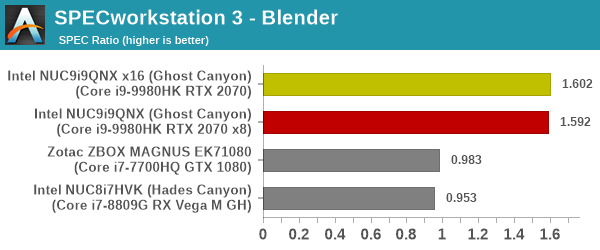
We find the Ghost Canyon NUC performing better than the reference configuration across all content creation workloads typically seen in the media and entertainment industry.
Product Development
The Product Development category comprises of eight distinct workloads:
- The Rodinia (CFD) workload benchmarks a computational fluid dynamics (CFD) algorithm.
- The WPCcfd workload benchmarks another CFD algorithm involving combustion and turbulence modeling.
- The CalculiX workload uses the Calculix finite-element analysis program to model a jet engine turbine's internal temperature.
- The Catia workload uses the catia-05 viewset from SPECviewperf 13 to replay traces generated by Dassault Systemes' CATIA V6 R2012 3D CAD application.
- The Creo workload uses the creo-02 viewset from SPECviewperf 13 to replay traces generated by PTC's Creo, a 3D CAD application.
- The NX workload uses the snx-03 viewset from SPECviewperf 13 to replay traces generated by the Siemens PLM NX 8.0 CAD/CAM/CAE application.
- The Solidworks workload uses the sw-04 viewset from SPECviewperf 13 to replay traces generated by Dassault Systemes' SolidWorks 2013 SP1 CAD/CAE application.
- The Showcase workload uses the showcase-02 viewset from SPECviewperf 13 to replay traces from Autodesk’s Showcase 2013 3D visualization and presentation application
| SPECworkstation 3.0.4 - Product Development Workloads | |||
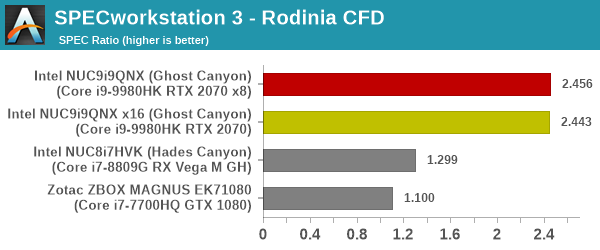
Almost all workloads see the Ghost Canyon NUC performing significantly better than the reference configuration. The NX workload alone seems to suffer, likely on account of the trace requiring features supported in professional graphics cards.
Life Sciences
The Life Sciences category comprises of four distinct test sets:
- The LAMMPS set comprises of five tests simulating different molecular properties using the LAMMPS molecular dynamics simulator.
- The NAMD set comprises of three tests simulating different molecular interactions.
- The Rodinia (Life Sciences) set comprises of four tests - the Heartwall medical imaging algorithm, the Lavamd algorithm for calculation of particle potential and relocation in a 3D space due to mutual forces, the Hotspot algorithm to estimate processor temperature with thermal simulations, and the SRAD anisotropic diffusion algorithm for denoising.
- The Medical workload uses the medical-02 viewset from SPECviewperf 13 to determine system performance for the Tuvok rendering core in the ImageVis3D volume visualization program.
| SPECworkstation 3.0.4 - Life Sciences Workloads | |||
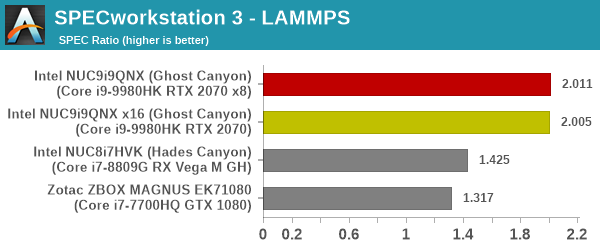
The trend repeats for all test sets in this category also, with the Ghost Canyon NUC acquitting itself in a creditable manner.
Financial Services
The Financial Services workload set benchmarks the system for three popular algorithms used in the financial services industry - the Monte Carlo probability simulation for risk assessment and forecast modeling, the Black-Scholes pricing model, and the Binomial Options pricing model.
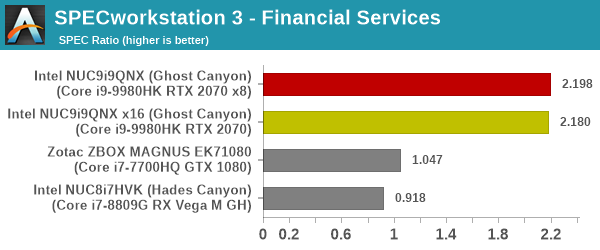
The large core count and ability to turbo to speeds of up to 5 GHz enable the NUC9i9QNX to process these algorithms in a fast manner.
Energy
The Energy category comprises of workloads simulating various algorithms used in the oil and gas industry:
- The FFTW workload computes discrete Fourier transforms of large matrices.
- The Convolution workload computes the convolution of a random 100x100 filter on a 400 megapixel image.
- The SRMP workload processes the Surface-Related Multiples Prediction algorithm used in seismic data processing.
- The Kirchhoff Migration workload processes an algorithm to calculate the back propogation of a seismic wavefield.
- The Poisson workload takes advantage of the OpenMP multi-processing framework to solve the Poisson's equation.
- The Energy workload uses the energy-02 viewset from SPECviewperf 13 to determine system performance for the open-source OPendTec seismic visualization application.
| SPECworkstation 3.0.4 - Energy Industry Workloads | |||

The NUCs seem to perform very poorly in the SRMP and Poisson workloads, but are otherwise quite good in the workloads in this category.
General Operations
In the General Options category, the focus is on workloads from widely used applications in the workstation market:
- The 7zip workload represents compression and decompression operations using the open-source 7zip file archiver program.
- The Python workload benchmarks math operations using the numpy and scipy libraries along with other Python features.
- The Octave workload performs math operations using the Octave programming language used in scientific computing.
- The Storage workload evaluates the performance of the underlying storage device using transaction traces from multiple workstation applications.
| SPECworkstation 3.0.4 - General Operations | |||
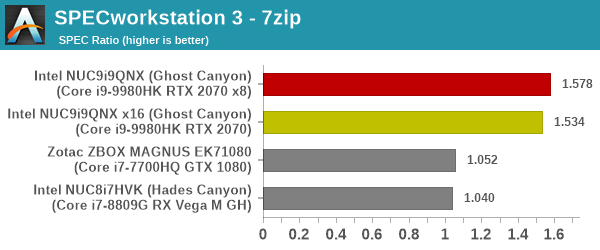
The Core i9-9980HK performs much better than the reference configuration as well as the older generation CPUs for the general operations. The storage results is again particularly interesting to analyze. Directly connecting the Optane SSD to the CPU's PCIe lanes results in a 40%+ performance improvement for the storage traces of professional applications.
GPU Compute
In the GPU Compute category, the focus is on workloads taking advantage of the GPU compute capabilities using either OpenCL or CUDA, as applicable:
- The LuxRender benchmark is the same as the one seen in the media and entertainment category.
- The Caffe benchmark measures the performance of the Caffe deep-learning framework.
- The Folding@Home benchmark measures the performance of the system for distributed computing workloads focused on tasks such as protein folding and drug design.
| SPECworkstation 3.0.4 - GPU Compute | |||
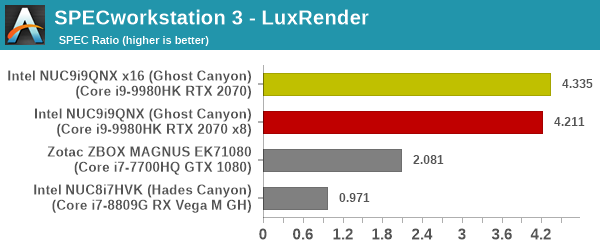










109 Comments
View All Comments
AdditionalPylons - Thursday, April 16, 2020 - link
The statement about noise is in the second last paragraph on page 3, here: https://www.servethehome.com/intel-nuc9vxqnx-nuc-r...but now that I read it again I realise it was probably without GPU, which naturally adds power draw and noise.
Ganesh, would it be possible for you to measure the noise with and without the GPU?
Spunjji - Friday, April 24, 2020 - link
I was interested in this aspect, too. The thermal module on the CPU doesn't look very promising, but the TDP is fairly low...leonlee - Thursday, April 16, 2020 - link
Thanks for putting this article together. Regarding optimizing for power delivery, what sort of approaches are in the works now? I imagine the low hanging fruit might be encouraging case manufacturers to integrate PSU wiring for space efficiency or aesthetics.cyrusfox - Thursday, April 16, 2020 - link
Biggest take away I see is at half the lanes, you still have 97% of the GPU performance in terms of frame rates. Thanks for the testing.For those looking for pictures, I would recommend Storage reviews write up - https://www.storagereview.com/review/intel-nuc-9-p...
If you want this in video form, where they specifically talked about noise from the NUC(It is surprisingly quiet even at load), I would say go check out Gamers Nexus video review - https://www.youtube.com/watch?v=CCoLJeUbZTc
Thank you Anandtech for getting out your review!
Operandi - Thursday, April 16, 2020 - link
Over priced Intel Junk. I know its trendy to dump on Intel but man this is just poorly designed overpriced garbage and thats too bad because the industry needs new ideas and form factors.Instead of the tiny blower heatsink being built into the compute element the cooling aspect should be part of the case. A front mounted 80 or 92mm fan that channels the air across a short heatpipe equipped heatsink, something like what is done in 1 and 2U servers. There could even be different tiers of chassis that would support larger cooling solutions that would support more powerful compute elements and larger GPUs. A design like this would create a new ecosystem with a wide variety or products for different uses and provide a way for partners to differentiate themselves.
AMD; work with some partners and build this.
Deicidium369 - Thursday, April 16, 2020 - link
The "partners" would rather work on something that would, you know, sell.Korguz - Friday, April 17, 2020 - link
man you are such an intel fanboy the way you bash AMD. looks like you gave up on the other thread you kept posing in cause the others put too much proof, and you had nothing else left to pro intel BS about.Deicidium369 - Friday, April 17, 2020 - link
Jimmy, go clean the basement. And you are such an AMD Fanboi.FACT - Intel sells 10:1 vs AMD - so do you go for 90% of the market or 10% of the market
I would BET that I have more and more current AMD systems than you do.
Korguz - Friday, April 17, 2020 - link
your " facts " are BS, just like was pointed out on the toms forums" I would BET that I have more and more current AMD systems than you do." and that is supposed to impress me ? or prove something ? who cares your post, regardless of what computers you claim to have, reek with anti AMD and are pro intel.
Korguz - Friday, April 17, 2020 - link
thats why you havent replied to any of the comments on the other thread about the 4900hs review, because your facts are BS, and you know it